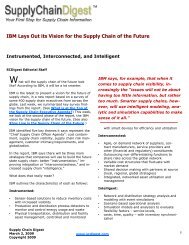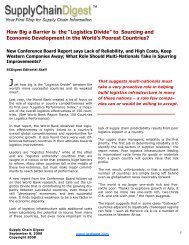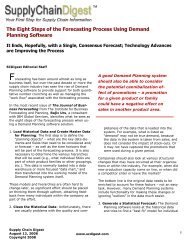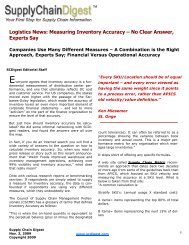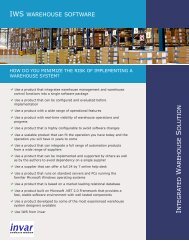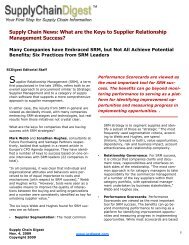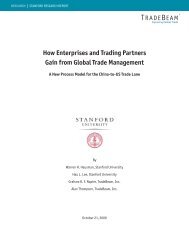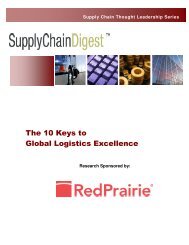DR. ELI GOLDRATT UNPLUGGED – PART 2 - Supply Chain Digest
DR. ELI GOLDRATT UNPLUGGED – PART 2 - Supply Chain Digest
DR. ELI GOLDRATT UNPLUGGED – PART 2 - Supply Chain Digest
Create successful ePaper yourself
Turn your PDF publications into a flip-book with our unique Google optimized e-Paper software.
Gilmore: People and companies have taken the Theory of Constraints and taken it in<br />
all kinds of different directions. Are they doing this well, or is it being misapplied?<br />
Goldratt: I would say most of them are valid.<br />
Gilmore: Some software vendors have adopted at least in part a Theory of<br />
Constraints orientation, especially in “optimization” products. What is the role of<br />
software in TOC?<br />
Goldratt: It depends. There are in fact cases where I don’t know how to solve a<br />
company’s issues without the software. For example, if you are dealing with large<br />
distribution networks of course you have to have the software. You’ll get killed trying<br />
to do it on spreadsheets. You also need software for big project management<br />
activities.<br />
Gilmore: Let’s talk about manufacturing in Europe and North America. There is a lot<br />
of general concern and political heat around “saving” manufacturing in the west,<br />
amidst low costs and pressure from China and other low cost countries. Can adoption<br />
of Theory of Constraints principles help revitalize those manufacturing companies?<br />
Goldratt: I think that question doesn’t consider what is really going on. What is this<br />
“save western manufacturing?” Let me talk about China and India <strong>–</strong> these are the<br />
two you are afraid or, right?<br />
I work a lot in China. You know the biggest problem in China is right now? Getting<br />
people <strong>–</strong> for the 2 nd shift. Can you imagine not enough people in China? Salaries are<br />
now skyrocketing. Statistics say that in 2004 salaries rose by 24%. When they are<br />
finalized in 2005, it will be much higher.<br />
Have you been in Shanghai, for example? You may have had images like I had of<br />
rickshaws and bicycles <strong>–</strong> No! This is a western town. With the best cars everywhere,<br />
and fewer bicycles than in Holland. I sent an assistant to go and look in some shops<br />
for bargains. She said, “Sorry Eli, the prices are the same as in Amsterdam.”<br />
So, China is not only becoming a big producer, but a huge consumer. If what we see<br />
now continues another 5-6 years, China will be by then the largest consumer market<br />
in the world.<br />
What’s happening in India is even more fascinating. I can say without blinking an<br />
eye that in India they have the best management of companies in the world. Better<br />
on average than I have seen in Europe of the United States. There problem was that<br />
they had put chains on themselves, in terms of regulations, tariffs, etc. This is gone.<br />
Because of it, the biggest boom is happening. India is also growing at 8-10 percent<br />
per year, and salaries are also rising rapidly. So again, in just a few years you will<br />
see a huge consumption market.<br />
Do you understand what together this means? In a few years, we will triple the world<br />
consumption in 5 to 6 years. You will see supply chain bottlenecks everywhere in the<br />
world. The best thing that ever happened to us is what is happening now in China<br />
and India. It is time to stop complaining about Chinese producers and focus on how<br />
to enter the Chinese market or export to China and India. What huge, beautiful<br />
markets.<br />
Goldratt Interview Part 2 © 2006. All Rights Reserved. 5




